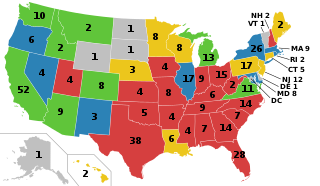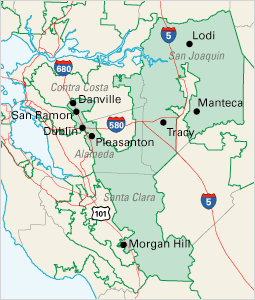
The 2003 Texas redistricting refers to a controversial mid-decade state plan that defined new Congressional districts. In the 2004 elections, this redistricting supported the Republicans taking a majority of Texas's House seats for the first time since Reconstruction. Opponents challenged the plan in three suits, combined when the case went to the United States Supreme Court in League of United Latin American Citizens v. Perry (2006).

The U.S. state of Alabama is currently divided into seven congressional districts, each represented by a member of the United States House of Representatives.

California is the most populous U.S. state; as a result, it has the most representation in the United States House of Representatives, with 52 Representatives. Each Representative represents one congressional district.

After the 2000 census, the Commonwealth of Pennsylvania was divided into 19 congressional districts, decreasing from 21 due to reapportionment. After the 2010 census, the number of districts decreased again to 18.

The New Jersey Redistricting Commission is a constitutional body of the government of New Jersey tasked with redrawing the state's Congressional election districts after each decade's census. Like Arizona, Idaho, Hawaii, Montana, and Washington; the redistricting is completed within an independent, bipartisan commission. The apportionment of members of the Redistricting Commission is carefully balanced between legislative and executive majorities and is purposefully designed to allow the minority party an equal number of seats on the commission.

Minnesota is known for a politically active citizenry, with populism being a longstanding force among the state's political parties. Minnesota has consistently high voter turnout; in the 2008 U.S. presidential election, 77.8% of eligible Minnesotans voted – the highest percentage of any U.S. state or territory – versus the national average of 61.7%. This was due in part to its same day voter registration laws; previously unregistered voters can register on election day, at their polls, with evidence of residency.
Vieth v. Jubelirer, 541 U.S. 267 (2004), was a United States Supreme Court ruling that was significant in the area of partisan redistricting and political gerrymandering. The court, in a plurality opinion by Justice Antonin Scalia and joined by Chief Justice William Rehnquist and Justices Sandra Day O'Connor and Clarence Thomas, with Justice Anthony Kennedy concurring in the judgment, upheld the ruling of the District Court in favor of the appellees that the alleged political gerrymandering was not unconstitutional. Subsequent to the ruling, partisan bias in redistricting increased dramatically in the 2010 redistricting round.

The 2012 United States elections took place on November 6, 2012. Democratic President Barack Obama won election to a second term, though the Republican Party retained control of the House of Representatives. As of 2020, this is the most recent election cycle in which neither the presidency nor a chamber of Congress changed partisan control.

Redistricting in Pennsylvania refers to the decennial process of redrawing state legislative and federal congressional districts in Pennsylvania.

The U.S. state of Arizona, in common with the other U.S. states, must redraw its congressional and legislative districts every ten years to reflect changes in the state and national populations. Redistricting normally follows the completion of the United States Census, which is carried out by the federal government in years that end in 0; the most recent Census took place in 2020. Historically, Arizona's legislature had control over the redistricting process. However, Proposition 106, passed in 2000, delegated the power to draw congressional and legislative boundaries to a bipartisan independent commission. The Arizona Independent Redistricting Commission (AIRC) comprises two Democrats, two Republicans, and one independent chair. County and local redistricting, which normally takes place along the same timeline as congressional and legislative redistricting, is carried out by the individual county and local governments rather than the AIRC.

Gerrymandering in the United States has been used to increase the power of a political party. Gerrymandering is the practice of setting boundaries of electoral districts to favor specific political interests within legislative bodies, often resulting in districts with convoluted, winding boundaries rather than compact areas. The term "gerrymandering" was coined after a review of Massachusetts's redistricting maps of 1812 set by Governor Elbridge Gerry noted that one of the districts looked like a salamander.

Redistricting in California has historically been highly controversial. Critics have accused legislators of attempting to protect themselves from competition by gerrymandering districts. Conflicts between the governor and the legislature during redistricting often have only been resolved by the courts.
Arizona State Legislature v. Arizona Independent Redistricting Commission, 576 U.S. 787 (2015), was a United States Supreme Court case where the Court upheld the right of Arizona voters to remove the authority to draw election districts from the Arizona State Legislature and vest it in an independent redistricting commission.
The National Democratic Redistricting Committee (NDRC) is a US organization that focuses on redistricting and is affiliated with the Democratic Party. The organization coordinates campaign strategy, directs fundraising, organizes ballot initiatives and files lawsuits against state redistricting maps. At launch, the organization announced that it intends to support Democratic candidates for local and state offices in order for them to control congressional map drawing in the redistricting cycle following the 2020 United States census.

The 2020 United States redistricting cycle is in progress following the completion of the 2020 United States census. In all fifty states, various bodies will re-draw state legislative districts. States that are apportioned more than one seat in the United States House of Representatives will also draw new districts for that legislative body.

League of Women Voters of Pennsylvania et al. v. Commonwealth of Pennsylvania et al.—abbreviated League of Women Voters v. Commonwealth—was a decision of the Pennsylvania Supreme Court on gerrymandering, concerning the power of the Pennsylvania General Assembly to draw maps based on partisan advantage. The Court ruled that the maps adopted by the Republican controlled legislature in 2011 was an unconstitutional partisan gerrymander under the Constitution of Pennsylvania.

Redistricting in Wisconsin is the process by which boundaries are redrawn for municipal wards, Wisconsin State Assembly districts, Wisconsin State Senate districts, and Wisconsin's congressional districts. Redistricting occurs—as in other U.S. states—once every decade, usually in the year after the decennial United States Census. According to the Wisconsin Constitution, redistricting in Wisconsin follows the regular legislative process, it must be passed by both houses of the Wisconsin Legislature and signed by the Governor of Wisconsin—unless the Legislature has sufficient votes to override a gubernatorial veto. Due to legislative gridlock, however, it has become common for Wisconsin redistricting to be conducted by courts. The 1982, 1992, and 2002 legislative maps were each created by panels of United States federal judges.
The Constitution of the United States delegates authority to regulate federal elections within a state to that state's "legislature". Traditionally, this has been interpreted to refer to "the legislative process used in [a] state, determined by that state's own constitution and laws." Advocates of the independent state legislature theory or independent state legislature doctrine (ISL) interpret this as limiting such authority to the state's elected lawmakers, while the state's executive branch, judiciary, or other bodies with legislative power have no powers of electoral oversight. Accordingly, in the event of a conflict between congressional election regulations enacted by a state's legislature and those derived from other sources of state law, that conflict must be resolved in favor of the state legislature's enactments, even over state constitutional provisions, and similarly over ballot initiatives which effectively modify a state constitution. Proponents of ISL further claim that adjudicating such purported conflicts is the province of the federal judiciary of the United States.
Moore v. Harper is a pending United States Supreme Court case related to the independent state legislature theory (ISL), arising from the redistricting of North Carolina's districts following the 2020 Census.















